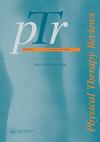横摇机动与侧卧机动对各向同性水平管BPPV:系统回顾
IF 0.8
Q4 REHABILITATION
引用次数: 3
摘要
背景与水平管良性阵发性位置性眩晕(BPPV)相关的眩晕通常比与后管BPPV相关的眩晕强烈得多。此外,水平管道BPPV通常会对动态平衡产生不利影响。目的:本系统综述的目的是确定在治疗各向异性水平管BPPV患者时,当前的翻滚和侧躺操作是最有效的。方法四名作者从成立到2020年访问CINAHL Complete、PubMed和Web of Science数据库。搜索词是地向性和(水平或横向)和眩晕。纳入研究的方法学严谨性使用由Medlicott和Harris创建的10项工具进行评估。结果本系统评价所采用的手法均疗效高,禁忌症少。由于半规管的解剖定位,水平管BPPV往往会在相对较短的时间内自行消退。然而,本系统综述中描述的操作可能会加速与水平管BPPV相关的长期症状的个体的自然缓解过程。结论:建议临床医生使用本系统综述中确定的一种手法治疗向地性水平管BPPV患者。在治疗老年人、肥胖者和/或行动迟缓者时,Gufoni操作可能比Baloh 360度滚转操作和/或Lempert 270度滚转操作更可取。如果患者无法忍受或不愿意进行操作,则强制延长体位是另一种可能的选择。本文章由计算机程序翻译,如有差异,请以英文原文为准。
Roll maneuvers versus side-lying maneuvers for geotropic horizontal canal BPPV: a systematic review
Abstract Background The vertigo associated with horizontal canal benign paroxysmal positional vertigo (BPPV) is usually much more intense than that associated with posterior canal BPPV. In addition, horizontal canal BPPV often adversely affects dynamic balance. Objectives The purpose of this systematic review was to determine which current roll and side-lying maneuvers are most effective while treating individuals with geotropic horizontal canal BPPV. Methods CINAHL Complete, PubMed, and Web of Science were the databases accessed from inception through 2020 by all four authors. The search terms were geotropic AND (horizontal OR lateral) AND vertigo. The methodological rigor of the included studies was evaluated using a 10-item tool created by Medlicott and Harris. Results All of the maneuvers included in this systematic review demonstrated high efficacy and few contraindications. Horizontal canal BPPV tends to spontaneously resolve in a relatively short period of time secondary to the anatomical positioning of the semicircular canals. However, the maneuvers described in this systematic review may expedite the natural remission process in individuals with long-term symptoms associated with horizontal canal BPPV. Conclusions It is recommended that clinicians utilize one of the maneuvers identified in this systematic review for individuals with geotropic horizontal canal BPPV. The Gufoni maneuver might be preferable to the Baloh 360-degree roll maneuver and/or the Lempert 270-degree roll maneuver when treating individuals who are elderly, who are obese, and/or who experience immobility. If an individual is unable to tolerate a maneuver or prefers not to have one performed, forced prolonged positioning is another possible option.
求助全文
通过发布文献求助,成功后即可免费获取论文全文。
去求助
来源期刊

Physical Therapy Reviews
REHABILITATION-
CiteScore
1.30
自引率
0.00%
发文量
26
期刊介绍:
Physical Therapy Reviews is an international journal which aims to publish contemporary reviews, discussion papers and editorials within physical therapy, and in those basic and clinical sciences which are the basis of physical therapy. The journal is aimed at all those involved in research, teaching and practice within the area of physical therapy. Reviews (both descriptive and systematic) are invited in the following areas, which reflect the breadth and diversity of practice within physical therapy: •neurological rehabilitation •movement and exercise •orthopaedics and rheumatology •manual therapy and massage •sports medicine •measurement •chest physiotherapy •electrotherapeutics •obstetrics and gynaecology •complementary therapies •professional issues •musculoskeletal rehabilitation
 求助内容:
求助内容: 应助结果提醒方式:
应助结果提醒方式:


